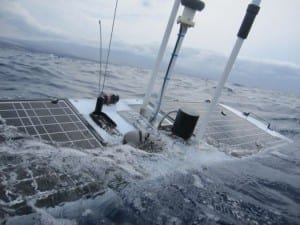After a year at sea, Liquid Robotics’ Wave Glider has set the record for the longest distance traveled by an autonomous robot.
In November of last year, Liquid Robotics dropped four of its brand new Wave Glider robots in the water just off the coast of San Francisco with hopes of making history and learning a thing or two in the offing. Two of the robots would set a course for Japan and the other two for Australia, each destination roughly 9,000 nautical miles away. It was to be the longest journey ever taken by any autonomous vehicle, a slow but steady swim across the entire Pacific Ocean that would collect and relay high resolution oceanographic and atmospheric data all along the way, stopping only for a quick maintenance check-up in Hawaii–if they made it that far at all.
And so Liquid Robotics’ engineers dumped their robots into the rolling water and turned them loose, uncertain as anyone else whether the robots could survive the weather, waves, and wildlife they would surely encounter on a trans-Pacific crossing. There are sharks out there, after all. Massive waves and gale-force winds. There’s a whole lot of saltwater out there, itself a force for destruction and disruption of mechanical systems. And yet almost exactly a year after launching the Wave Glider known as “Papa Mau” navigated around the Great Barrier Reef and arrived off the coast of Queensland Australia last week, half a world away from where it started and only somewhat worse for wear.
Don’t lose the significance of this story in this milestone. Papa Mau and the three other Wave Gliders that are still out there paddling toward their destinations have certainly done something groundbreaking, but as with most inaugural journeys this one will soon pale in comparison to the impact of the voyages that will follow it. Liquid Robotics set out to prove that its Wave Gliders could spend months, even a year, traversing the ocean, beaming back data without stopping for so much as a cigarette (other than that short Hawaiian layover, that is). Having answered the key question about whether the technology can actually stand up to this task, Liquid Robotics can now address a much broader question: what do we want to know next?
“We always suspected that this kind of ocean crossing was possible, and we designed this platform to do it,” says Graham Hine, senior vice president of operations at Liquid Robotics. “But to actually achieve a 9,000-mile journey from the northern hemisphere to the southern hemisphere, that was the stretch goal for this platform. The wave-harnessing capability should be perpetual as long as there are waves in the ocean, but to demonstrate that the hardware can actually stand up to that is the biggest part of this technology demonstration.”
For those not up to speed on Wave Glider, a quick primer: Wave Glider is the first unmanned and autonomous maritime robot that draws its propulsive power solely from the ocean’s waves. The two part system consists of a float that rides on the surface of the water and a tethered submarine unit that moves beneath the surface roughly 23 feet below. Wave Glider doesn’t turn wave energy into power for motors or anything like that–the unique construction of the robot allows it to gain a little forward thrust with every wave that lifts the float unit (visual explanationhere). It doesn’t move fast, but as long as the ocean continues to move so does the robot.
That makes Wave Glider ideal for a range of scientific missions, the kinds of data gathering expeditions that don’t need to move fast and in fact don’t want to. Solar panels spread across the float unit can power an array of instruments–in Papa Mau’s case, those include a weather station measuring air temperature, barometric pressure, and wind speeds, as well as a wave sensor recording height, period, and direction, a submersible fluorometer capable of measuring chlorophyll-A, and a CTD (conductivity, temperature, depth) payload also able to measure dissolved oxygen in the water. The sensor package wasn’t designed to discover anything in particular, but simply to create an unprecedented data set–refreshed every ten minutes and uploaded to the Iridium satellite network–as Papa Mau trudged across the Pacific. That’s more or less the entire idea behind Wave Glider: gather ocean data consistently and without interruption, until the end of time if possible.
The Latest Streaming News: Oceangoing Robot updated minute-by-minute
Bookmark this page and come back often
Latest NEWS
Latest VIDEO








